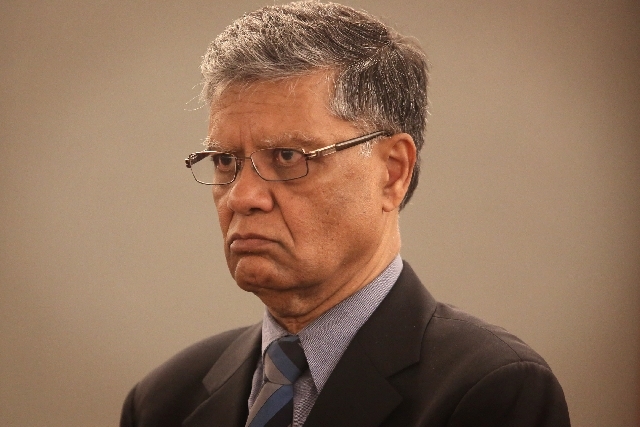Desai trial continues with testimony on unsafe sterilization practices
On a few occasions during his year-long employment at Dr. Dipak Desai’s clinics, gastrointestinal technician Joshua Cavett said the machinery that sterilized scopes that had entered patients’ body malfunctioned, leaving him and his fellow employees to take an untraditional approach.
It was one that, when described Tuesday in District Court, even made attorneys squeamish — they didn’t want to hear the testimony again immediately after lunch.
When the cleaning appliance was out of order, scopes used during colonoscopies and during down-the-throat endoscopies were tossed into the same bin along with “bite locks,” which are inserted into patients’ mouths to prevent them from pushing the probe out during procedures.
They were brushed out, but sat in the same cleansing bin for 20 minutes.
Eventually, the bins would be flushed and refilled with fresh disinfectant.
“You’d put two scopes in three or four times (a day) and then change the solution,” Cavett said. “After six to eight scopes it would be pretty dirty, there would be fecal matter all around it, just floating.”
Cavett said when he prepared the scopes for procedures, he would look through them and sometimes see flakes of fecal matter at the end. He said he would return the equipment to the sterilization room, but couldn’t testify what other technicians did when presented with the same situation.
Desai and nurse anesthetist Robert Lakeman are on trial facing nearly 30 charges related to the 2007 hepatitis C outbreak.
Desai is alleged to have forced nurse anesthetists to cut costs by reusing syringes, double-dipping into the same propofol vial for different patients. Desai and Lakeman each face charges including second-degree murder, criminal neglect of patients, theft and insurance fraud.
Cavett said he worked at Desai’s clinics for a year and three months before they were shut down in January 2008 following a federal investigation into the outbreak.
He said the bite locks, intended to be used one time, were used multiple times throughout the day. Cavett witnessed the same vial of propofol being used on different patients “until it was gone” and described the clinic as “dirty.”
Cavett said that while most colonoscopies took approximately 15 minutes, when Desai was in charge, the procedure took only five minutes.
“Dr. Desai was well known for speeding up his colonoscopies,” Cavett testified.
Prosecutors called victims of the outbreak to the witness stand to back their charges and describe what contracting Hepatitis C has done to their lives.
Sonia Rivera, who received $1.9 million in a civil lawsuit, said she continues to suffer from the symptoms.
“Starting with my diagnosis, everything was different,” she said through a Spanish interpreter. “The first months were really tough. I will feel depressed a lot, feeling very tired and my head would ache a lot and I will cry a lot. Everything changed.”
Gwendolyn Martin said she received two procedures on Sept. 20, 2007 and Sept. 21, 2007 and thought the waiting room was far too crowded for comfort, echoing another hepatitis C victim’s testimony on Monday. In October, she was diagnosed with the deadly virus.
“I had no idea, I had heard of hepatitis C, but I had no idea what it was,” Martin said.
She tearfully recalled the flu-like symptoms she had and her lack of appetite, which led to a 25-pound loss. After 48 weeks of treatment, her condition has not subsided significantly.
“My muscle tone left, I lost weight, I was depressed, I was very tired, I stayed confused, my memory got very bad,” she said. “It was very frightening.”
Earlier in the day, Dr. Satish Sharma explained that he was on the verge of forming a business partnership with Desai when the indictments were issued and Desai’s plans to open a new surgical center were thwarted.
Prosecutors grilled Sharma on knowledge of standards of care and changes that have been made in recent years after Sharma testified that as long as a vial of propofol and syringe were used on the same patient, there was no problem with not changing the syringe.
He was then told that the American Association of Nurse Anesthetists and the Center for Disease Control issued a directive in 2002, saying that it was unsafe to use the same syringe on the same patient.
“I’m not aware of it, but there has to be an explanation for that,” Sharma said. “How can you transmit the infection from one patient (to the same patient) when you are using the same needle, same syringe, same vial and same patient? Someone has to explain it to me and I’ll stop doing it.”
Sharma likened the ruling to ordering a surgeon to change knives between each incision.

















